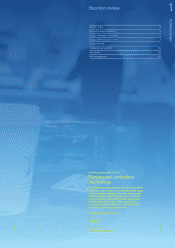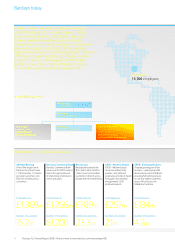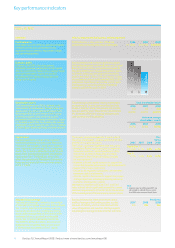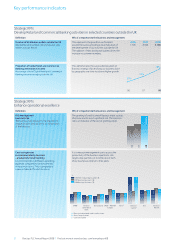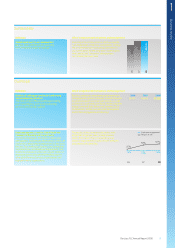Barclays 2008 Annual Report Download - page 15
Download and view the complete annual report
Please find page 15 of the 2008 Barclays annual report below. You can navigate through the pages in the report by either clicking on the pages listed below, or by using the keyword search tool below to find specific information within the annual report.
1
Business review
Barclays PLC Annual Report 2008 13
Outlook
We expect 2009 to be another challenging year with continuing downturns
or recessions in many of the economies in which we are represented. In
2008 our profits were reduced by the impacts of substantial gross credit
market losses. In 2009, we expect the impact of such credit market losses
to be lower. Whilst we are confident in the relative quality of ourmajor
books of assets, we also expect the recessionary environments in the UK,
Spain, South Africa and the US to increase the loan loss rates on our
loans and advances.
Governments in the UK and elsewhere have taken significant
measures to assist borrowers and lenders in response to the emerging
recession, including reducing official interest rates. The low interest rate
environment will have the impact of substantially reducing the spread
generated on our retail and commercial banking deposits, particularly
in the UK, but we expect the combined impact of these government
measures to be positive for the economy in time.
2009 Trading
Customer and client activity levels were high in the first month of 2009,
and we have had a good start to the year. In particular, the operating
performance of Barclays Capital, benefiting from the now complete
integration of the Lehman Brothers North American businesses, was
extremely strong. The trends that lie behind the strong operating
performance in Global Retail and Commercial Banking in 2008 were
again observable in its performance in January.
Conclusion
I end this review by recording the Board’s appreciation of the dedication
and hard work of our 150,000 people. We are doing more business with
more customers and clients than at any time in our history, and have
generated substantial profits. That we have been able to do this reflects
the continuing focus of Barclays employees on delivering high-quality
service to clients and customers despite the difficult conditions of the year.
John Varley
Group Chief Executive
payments will be made on a quarterly basis. We will set out our dividend
policy at the Annual General Meeting in April.
– We must ensure that our capital position is robust and our balance sheet
well-managed. We set out within the FinancialReview our approach to
managing leverage in the balance sheet, and our expectations for capital
ratios. For 2009, returns will rank ahead of growth.
– To create good returns at this time, we must preserve strategic and
operational choice. As conditions remain very difficult in 2009, we
expect that there will be considerable value at stake for our shareholders
in decisions that we take relating to resource utilisation, capital allocation
and risk management. Our objective over time is to ensure that the cost
of the capital we raised last November is covered many times over by
the benefits of pursuing our strategy.
– We must deliver solid profitability notwithstanding the global downturn.
Our diversified income streams have served us well in recent years and
have enabled us to absorb substantial costs from the financial crisis.
We expect them to continue to do so.
– We will seek to manage the composition of our profits, and capital
allocation, to ensure that we optimise returns from our universal
banking business model. What does this mean? It is clear to us that
in the future there will be more capital in the banking system, and less
leverage, particularly in capital markets businesses. This will be true
at Barclays too, and will govern our approach to capital allocation and
expected returns. We expect to see balance sheet utilisation by Barclays
Capital fall over time, which will help us to deliver strengthening returns.
We believe that the businesses that we have built from the integration
of Lehman Brothers North American businesses and Barclays Capital
will help in this regard, since the capital intensity of the advisory
businesses in M&A and of the flow businesses in fixed income,
currencies, equities and credit will be lower, once we have managed
down our credit market exposures.
Goals
We set out last year our goals for economic profit for 2008 through 2011.
Those were based on, amongst other things, the then regulatory capital
requirements for the business and the then cost of equity. The regulatory
capital requirements were significantly increased last year by the UK
Financial Services Authority. The observed cost of equity has also increased.
It is right, therefore, that we revisit our goals, to ensure that they are
properly aligned with our new return and balance sheet objectives, and
with the interests of our owners. We intend to publish revised goals in due
course that reflect the changes to the environment in the past two years.
“
Our performance reflects the continuing
focus of Barclays employees on delivering
high-quality service to clients and customers
despite the difficult conditions of the year.
”


